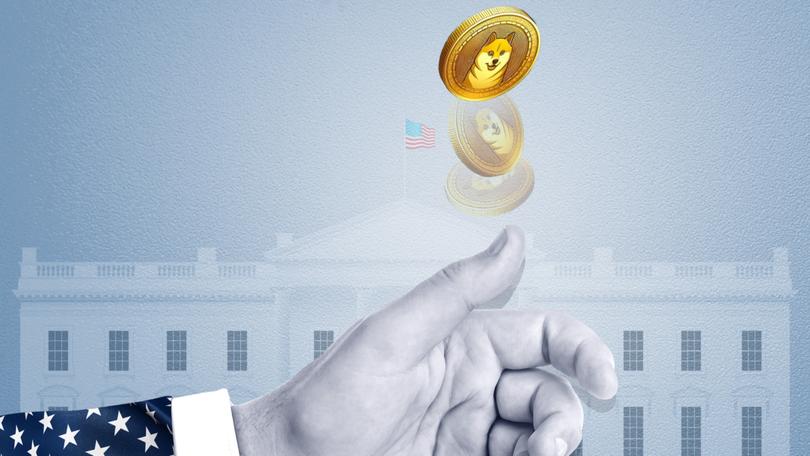The Economist: Will Trump’s crypto frenzy end in disaster?

“Get your $TRUMP now,” came the message from America’s president-elect three days before his inauguration.
The commander-in-chief’s meme cryptocurrency, the aggregate value of which has so far peaked at almost $15 billion ($23.8b), is far from the only sign of the administration’s ardour for digital assets.
One new government department (DOGE) has been christened after another meme coin. It is now quicker to list people close to the president who do not have significant financial interests in crypto than those who do.
Sign up to The Nightly's newsletters.
Get the first look at the digital newspaper, curated daily stories and breaking headlines delivered to your inbox.
By continuing you agree to our Terms and Privacy Policy.For anyone not paying attention, an executive order on January 23 made things clear: digital assets, it announced, would play “a crucial role in innovation and economic development in the United States, as well as our Nation’s international leadership”.
What does this spectacular merger of hype cycle and national governance mean for American finance? The Biden administration had worked hard to prevent the crypto industry from infiltrating Wall Street.
Tight rules made it prohibitively expensive for banks to hold digital assets on behalf of clients, and stopped them from pioneering their own crypto products, such as stablecoins (tokens pegged to the dollar or other assets). The Federal Deposit Insurance Corporation (FDIC), a watchdog, obstructed dozens of such projects on the basis that it did not know how digital assets ought to be treated in regulatory filings.
Now, on many issues, banks and the crypto industry are pushing in the same direction, and face little resistance. Expect, as a consequence, new and enormously profitable forms of risk-taking to emerge. In time, there will also be furious debates when digital upstarts, who have the full favour of the White House, come to clash with veterans of American banking.
Diamond days for diamond hands
The cryptofication of mainstream finance is already under way. On January 21, Travis Hill, interim chair of the FDIC, declared that he wanted regulation of crypto to be more transparent, and that all law-abiding customers should have access to bank accounts. Crypto advocates are hopeful the new administration will bring an end to “debanking” (when someone is denied or loses access to banking services owing to legal concerns).
The industry has been particularly vulnerable to this because of fears about money-laundering. Then on January 23 the Securities and Exchange Commission, America’s main financial regulator, altered its guidance so that financial institutions no longer have to account, on their own balance-sheets, for crypto assets held on behalf of customers.
These changes will affect just about every institution on Wall Street. Brian Moynihan, chief executive of Bank of America, has said that banks will embrace cryptocurrencies, such as stablecoins, that can facilitate transactions. Many are experimenting with crypto tokens that convey ownership of shares in money-market funds. They are also set to begin building up their trading and custody of crypto assets as soon as they can be certain about the details of the new regulatory regime.
To enable this new focus on digital assets, some institutions will probably purchase crypto firms. Dylan Walsh of Oliver Wyman, a consultancy, thinks that there could also be an acquisition spree in the opposite direction, with digital-asset companies buying mainstream outfits. A few crypto firms could even attempt to purchase institutions with banking licences, allowing them to take deposits and offer loans. The result would be much more overlap between the crypto industry and traditional finance. It would then be difficult for any future Democratic president to change course on crypto.
“As a practical matter it’s much harder for regulators to un-ring the bell,” notes Julie Andersen Hill of the University of Wyoming.
Yet traditional finance and the crypto industry are not aligned on every issue. The biggest point of contention concerns the Federal Reserve’s payment rails.
Around 9000 firms hold master accounts with the central bank. Such accounts allow their owners to make payments without use of an intermediary, reducing the cost and complexity of transactions. Custodia Bank, a crypto-investment outfit that holds a depository licence in Wyoming, applied for a master account in 2020, only to be rejected. Kraken Financial, another crypto firm, made its own application four years ago. It is still awaiting a decision from the Fed.
Traditional banks are happy with this state of affairs. The Bank Policy Institute and American Bankers Association, two lobby groups, have supported the Fed’s right to block access to master accounts. They have stressed the need to guard against credit, cybersecurity and reputational risk, especially relating to money-laundering and terrorist financing.
Banks also gripe that they face higher regulatory standards than other fintech firms. In contrast, Caitlin Long, chief executive of Custodia, has complained that mainstream lenders are gatekeeping their access to the country’s financial rails. The argument is likely to run and run.
Although Mr Trump may select appointees to the Fed’s board in part on their attitude to widening access to the central bank’s payment infrastructure, only two new positions will be up for grabs in the next four years, since the Fed’s seven governors serve staggered 14-year terms.
Reasons for FUD
Many will be glad of such obstacles to the Trump administration’s agenda. Michael Barr, departing head of financial supervision at the Fed, has loudly warned about the dangers of finance’s cryptofication. The industry has a dubious reputation for a reason: Sam Bankman-Fried, founder of FTX, one of the world’s biggest crypto exchanges, was last year sentenced to 25 years in prison for fraud. Changpeng Zhao, founder of a rival exchange, has spent four months locked up for money-laundering. These are the sort of failures regulators want to keep from mainstream finance.

There are also fears about the sheer volatility of crypto. Steven Kelly of Yale University says that he is worried about the consequence of “ties between what happens in crypto prices and what happens to banks”.
If bank deposits are vulnerable to movements in the crypto market, institutions will become more vulnerable to runs. That, Mr Kelly notes, is what happened at Silvergate and Signature, two crypto-focused banks which collapsed in 2023. Both were broken by a tumble in cryptocurrency prices that began in late 2021 and then reverberations from FTX’s collapse.
Almost anywhere you look — from the popularity of gambling and novel forms of retail investing to soaring crypto prices and the electorate’s choice of president — America is embracing risk.
For financiers the rise of digital finance provides some new and large moneymaking opportunities. For the American consumer it may even provide valuable innovations. But the Trump administration is eager to find out just how much risk Americans will bear. And if the merger between Wall Street and the blockchain is managed poorly, the costs could be extreme.
Originally published as Will America’s crypto frenzy end in disaster?
